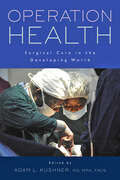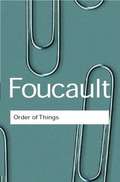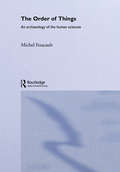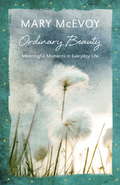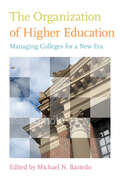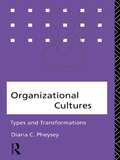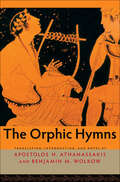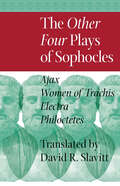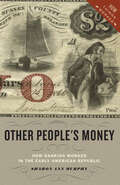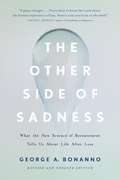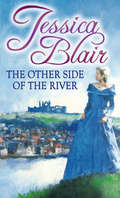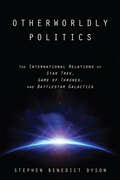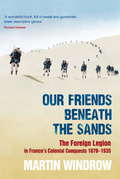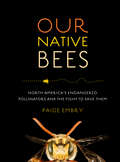- Table View
- List View
Operation Health: Surgical Care in the Developing World (Operation Health)
by Adam L. KushnerA teenage mother arrives by donkey cart to a hospital after attempting to deliver her baby in the bush. A young father faces the loss of a leg after receiving a gunshot wound that will not heal. A man walks miles to a hospital for a pain in his side caused by an appendix that burst five days earlier. Without access to surgical resources, millions of people with conditions like these become disabled or die. In Operation Health, Adam L. Kushner argues that not only are severe medical conditionsâ€� like a strangulated hernia or obstetric fistulaâ€�treatable by surgical means in low-income countries; they are, in fact, surgically preventable. Although the World Bank estimates that 11 percent of the global disease burden is treatable by surgery, more than a quarter of the world’s population lacks access to straightforward and life-saving surgical procedures.Operation Health makes a strong and compelling justification for adding surgical care to the global health agenda by providing an overview of dangerous but repairable medical conditions common in developing countries. Every chapter opens with a vignette by Kushner which tells the remarkable story of the patients and situations he encountered in the field. Carefully crafted case studies demonstrate the power of surgery to heal people suffering from potentially debilitating conditions, including clubfoot, obstructed labor, and broken bones.The chaptersâ€�written by world-renowned surgical expertsâ€�cover related medical topics such as epidemiology, women’s health, cancer, and trauma in locations from Sierra Leone to Nepal, Ghana, Mongolia, and elsewhere. This detailed and compassionate book will be of great interest to medical professionals, students, public health policy makers, philanthropic donors, and those with a general interest in global health.
Operation Mayhem
by Damien Lewis Steve Heaney, MC2,000 blood-crazed rebels. 26 elite British soldiers. One man's explosive true story.Airlifted into the heart of the Sierra Leone jungle in the midst of the bloody civil war in 2000, 26 elite operators from the secret British elite unit X Platoon were sent into combat against thousands of Sierra Leonean rebels.Notorious for their brutality, the rebels were manned with captured UN armour, machine-guns and grenade-launchers, while the men of X Platoon were kitted with pitiful supplies of ammunition, malfunctioning rifles, and no body armour, grenades or heavy weapons.Intended to last only 48 hours, the mission mutated into a 16-day siege against the rebels, as X Platoon were denied the back-up and air support they had been promised, and were forced to make their stand alone. The half-starved soldiers, surviving on bush tucker, fought with grenades made from old food-tins and defended themselves with barricades made of sharpened bamboo-sticks, tipped in poison given to them by local villagers.Sergeant Steve Heaney won the Military Cross for his initiative in taking command after the platoon lost their commanding officer. OPERATION MAYHEM recounts his amazing untold true story, full of the rough-and-ready humour and steely fortitude with which these elite soldiers carried out operations far into hostile terrain.
Oral Anatomy, Histology and Embryology E-Book (Self-assessment Picture Tests In Dentistry Ser.)
by Barry K.B Berkovitz G. R. Holland Bernard J. MoxhamWritten by dentists for dentists – authors who know exactly what students need for safe clinical practice Includes comprehensive coverage of the soft tissues of the oral region and skeletal structures of the head, including vasculature and innervation Contains topics not found in other titles – including tooth eruption morphology and the effects of aging on teeth and associated soft tissues Includes clear discussion of sectional and functional morphology – mastication, swallowing, and speech Addresses physical and chemical properties of the tooth structure – enamel, dentine, pulp and cementum Many chapters include Clinical Considerations which explore pathological findings relating to the topic as well as other areas of importance such as the use of local anaesthesia, TMJ disorders and malocclusion Explores bone structure and remodelling – including potential bone atrophy following tooth extraction, its relevance to orthodontic treatment and implantology, trauma and malignancy Rich with over 1000 images including schematic artworks, radiological images, electron-micrographs, cadaveric and clinical photographs all specially selected to make learning and recall as easy as possible Includes the use of mnemonics and emboldened key terms to aid recall On-line self-assessment module aids revision and self-testing Many topics now boxed to aid learning and rapid revision Explores recent areas of research including tissue engineering techniques, TMJ replacement and the discovery of new chromosomal abnormalities
The Order Of Things: An Archaeology Of The Human Sciences (PDF)
by Michel FoucaultWhen one defines "order" as a sorting of priorities, it becomes beautifully clear as to what Foucault is doing here. With virtuoso showmanship, he weaves an intensely complex history of thought. He dips into literature, art, economics and even biology in The Order of Things, possibly one of the most significant, yet most overlooked, works of the twentieth century. Eclipsed by his later work on power and discourse, nonetheless it was The Order of Things that established Foucault's reputation as an intellectual giant. Pirouetting around the outer edge of language, Foucault unsettles the surface of literary writing. In describing the limitations of our usual taxonomies, he opens the door onto a whole new system of thought, one ripe with what he calls "exotic charm. " Intellectual pyrotechnics from the master of critical thinking, this book is crucial reading for those who wish to gain insight into that odd beast called Postmodernism, and a must for any fan of Foucault.
The Order of Things: An Archaeology Of The Human Sciences (Routledge Classics)
by Michel FoucaultWhen one defines "order" as a sorting of priorities, it becomes beautifully clear as to what Foucault is doing here. With virtuoso showmanship, he weaves an intensely complex history of thought. He dips into literature, art, economics and even biology in The Order of Things, possibly one of the most significant, yet most overlooked, works of the twentieth century. Eclipsed by his later work on power and discourse, nonetheless it was The Order of Things that established Foucault's reputation as an intellectual giant. Pirouetting around the outer edge of language, Foucault unsettles the surface of literary writing. In describing the limitations of our usual taxonomies, he opens the door onto a whole new system of thought, one ripe with what he calls "exotic charm". Intellectual pyrotechnics from the master of critical thinking, this book is crucial reading for those who wish to gain insight into that odd beast called Postmodernism, and a must for any fan of Foucault.
Ordinary Beauty: Meaningful Moments in Everyday Life
by Mary McEvoyActress and writer Mary McEvoy has struggled with depression for many years, trying to reconcile her life in the public eye with private pain. Many things have helped Mary to come to terms with her depression: the rituals of farming life in Co. Westmeath, the excitement of the stage, the love of friends and family. Ultimately, Mary has found her way through, and it's the little things that have really helped: the beauty of the world around her, the quiet pleasures of sweeping the yard, or cooking a simple meal.In Ordinary Beauty, Mary celebrates life's seemingly insignificant moments and invests them with fresh beauty and meaning, as well as a wry humour. Never has 'living in the moment' been so enjoyable, or so comforting.
Organisational Learning and Effectiveness
by Denton JohnLearning is increasingly seen as crucial to the success of organisations but many studies of the subject offer very little empirical evidence to substantiate this. Based upon in-depth research, including over seventy interviews with managers and employees, Organisational Learning and Effectiveness is an original and comprehensive analysis of learning organisations. Contents include:* detailed case studies of five major international companies: Coca-Cola and Schweppes Beverages, 3M, Siebe, Mayflower and Morgan Crucible* the intellectual origins of organisational learning* best practice in organisational learning* the importance of leadership roles and skills*a critical examination of the usefulness and relevance of organisational learning and effectiveness.Integrating management theory and practice, this volume is an extremely valuable resource for all those with an interest in organisational behaviour and human resource development.
The Organization of Higher Education: Managing Colleges for a New Era
by Michael N. BastedoColleges and universities are best understood as networks of departments working together to fulfill a mission of education, innovation, and community partnership. To better understand how these large and complex institutions function, scholars can apply organizational and strategic planning concepts made familiar by business management. This book follows that model and explores the new and emerging ways by which organizational theories address major contemporary concerns in higher education. The contributors to this volume are both influenced and inspired by the pioneering work of Marvin Peterson and his four-decade career researching higher education organization. Comprising a serious reexamination of the field, the essays review past and current thinking, address the field’s core theoretical traditions, and pursue exciting new lines of inquiry, including the organizational dynamics of diversity and social movement organizations. Ideal for courses in administration and theory, this book reinvigorates the study of higher education as an organization and encourages scholars to rediscover the value of organizational principles in all areas of higher education research. Contributors: Michael N. Bastedo, University of Michigan; Patricia J. Gumport, Stanford University; James C. Hearn, University of Georgia; Adrianna Kezar, University of Southern California; Jason Lane, State University of New York at Albany; Simon Marginson, University of Melbourne; Michael K. McLendon, Vanderbilt University; Anna Neumann, Columbia University; Brian Pusser, University of Virginia; Fabio Rojas, Indiana University; Daryl G. Smith, Claremont Graduate University; William G. Tierney, University of Southern California; and the late J. Douglas Toma, University of Georgia
The Organization of Higher Education: Managing Colleges for a New Era
by Michael N. BastedoColleges and universities are best understood as networks of departments working together to fulfill a mission of education, innovation, and community partnership. To better understand how these large and complex institutions function, scholars can apply organizational and strategic planning concepts made familiar by business management. This book follows that model and explores the new and emerging ways by which organizational theories address major contemporary concerns in higher education. The contributors to this volume are both influenced and inspired by the pioneering work of Marvin Peterson and his four-decade career researching higher education organization. Comprising a serious reexamination of the field, the essays review past and current thinking, address the field’s core theoretical traditions, and pursue exciting new lines of inquiry, including the organizational dynamics of diversity and social movement organizations. Ideal for courses in administration and theory, this book reinvigorates the study of higher education as an organization and encourages scholars to rediscover the value of organizational principles in all areas of higher education research. Contributors: Michael N. Bastedo, University of Michigan; Patricia J. Gumport, Stanford University; James C. Hearn, University of Georgia; Adrianna Kezar, University of Southern California; Jason Lane, State University of New York at Albany; Simon Marginson, University of Melbourne; Michael K. McLendon, Vanderbilt University; Anna Neumann, Columbia University; Brian Pusser, University of Virginia; Fabio Rojas, Indiana University; Daryl G. Smith, Claremont Graduate University; William G. Tierney, University of Southern California; and the late J. Douglas Toma, University of Georgia
Organizational Behavior v 1.1
by Talya Bauer Berrin ErdoganTwo leading researchers in Management, Talya Bauer and Berrin Erdogan, bring you a new Organizational Behavior textbook that bridges the gap between theory and practice with a distinct "experiential" approach. On average, a worker in the USA will change jobs 10 times in 20 years. In order to succeed in this type of career situation, individuals need to be armed with the tools necessary to be life-long learners. To that end, this book is not be about giving students all the answers to every situation they may encounter when they start their first job or as they continue up the career ladder.
Organizational Cultures: Types and Transformations
by Diana C. PheyseyFirst published in 1993. Routledge is an imprint of Taylor & Francis, an informa company.
Organizational Improvisation
by Miguel Pina Cunha Ken KamocheThe relatively new field of organizational improvisation is concerned with the pressures on organizations to react continually to today's ever-changing environment. Organizational improvisation has important implications for such subjects as product innovation, teamworking and organizational renewal, and this new book brings together some of the best and most thought-provoking papers published in recent years. This area is now emerging as one of the most important in organizational science, and this book provides a comprehensive collection suitable for students, researchers and practitioners alike.
The Orphic Hymns
by Apostolos N. Athanassakis Benjamin M. WolkowAt the very beginnings of the Archaic Age, the great singer Orpheus taught a new religion that centered around the immortality of the human soul and its journey after death. He felt that achieving purity by avoiding meat and refraining from committing harm further promoted the pursuit of a peaceful life. Elements of the worship of Dionysus, such as shape-shifting and ritualistic ecstasy, were fused with Orphic beliefs to produce a powerful and illuminating new religion that found expression in the mystery cults. Practitioners of this new religion composed a great body of poetry, much of which is translated in The Orphic Hymns.The hymns presented in this book were anonymously composed somewhere in Asia Minor, most likely in the middle of the third century AD. At this turbulent time, the Hellenic past was fighting for its survival, while the new Christian faith was spreading everywhere. The Orphic Hymns thus reflect a pious spirituality in the form of traditional literary conventions. The hymns themselves are devoted to specific divinities as well as to cosmic elements. Prefaced with offerings, strings of epithets invoke the various attributes of the divinity and prayers ask for peace and health to the initiate. Apostolos N. Athanassakis and Benjamin M. Wolkow have produced an accurate and elegant translation accompanied by rich commentary.
Orthodontics - E-Book: Current Principles and Techniques
by Lee W. Graber Robert L. Vanarsdall Jr. Katherine W. Vig Greg J. HuangComprehensive, cutting-edge content prepares you for today’s orthodontics! Orthodontics: Current Principles and Techniques, 6th Edition provides evidence-based coverage of orthodontic diagnosis, planning strategies, and treatment protocols, including esthetics, genetics, temporary anchorage devices, aligners, technology-assisted biomechanics, and much more. New to this edition is an Expert Consult website using videos and additional visuals to show concepts difficult to explain with words alone. Expert Consult also adds three online-only chapters, research updates, and a fully searchable version of the text. From respected editors Lee Graber, Robert Vanarsdall, Katherine Vig, and Greg Huang, along with a veritable Who’s Who of expert contributors, this classic reference has a concise, no-nonsense approach to treatment that makes it the go-to book for orthodontic residents and practitioners!Comprehensive coverage provides a one-stop resource for the field of orthodontics, including foundational theory and the latest on the materials and techniques used in today’s practice.Experienced, renowned editors lead a team of expert, international contributors, bringing the most authoritative clinical practice and supporting science from the best and brightest in the industry.More than 3,400 images include a mixture of radiographs, full-color clinical photos, and anatomic or schematic line drawings, showing examples of treatment, techniques, and outcomes.Extensive references make it easy to look up the latest in orthodontic research and evidence-based information, and all references also appear online.Detailed, illustrated case studies show the decision-making process, showing the consequences of various treatment techniques over time. NEW! Seven all-new chapters include Orthodontic Diagnosis and Treatment Planning with Cone-Beam Computed Tomography Imaging; Upper Airway, Cranial Morphology, and Sleep Apnea; Management of Impactions; Iatrogenic Effects of Orthodontic Appliances; Minimally and Non-Invasive Approaches to Accelerate Tooth Movement; Management of Dental Luxation and Avulsion Injuries in the Permanent Dentition; and Patient Management and Motivation for the Child and Adolescent Patient.NEW! Expert Consult website includes online-only chapters, instructional videos, many references linked to PubMed, and research updates including additional case studies.UPDATED CHAPTERS include Biomechanical Considerations with Temporary Anchorage Devices, Bonding in Orthodontics, Clear Aligner Treatment, Lingual Appliance Treatment, Psychological Aspects of Diagnosis and Treatment, Clinically Relevant Aspects of Dental Materials Science in Orthodontics, The Biologic Basis of Orthodontics, and more.New co-editor Greg J. Huang is joined by new contributors who are highly regarded experts within their respective subspecialties in orthodontics.
The Other Four Plays of Sophocles: <I>Ajax, Women of Trachis, Electra, </I>and <I>Philoctetes</I>
by SophoclesThere are seven surviving tragedies by Sophocles. Three of them form the Theban Plays, which recount the story of Thebes during and after the reign of Oedipus. Here, David Slavitt translates the remaining tragedies—the "other four plays:" Ajax, Women of Trachis, Electra, and Philoctetes.Punchy and entertaining, Slavitt reads Athena's opening line in Ajax as: "I’ve got my eye on you, Odysseus. Always." By simplifying the Greek and making obscure designations more accessible—specifying the character Athena in place of "aegis-wearing goddess," for example—his translations are highly performable. The Other Four Plays of Sophocles will help students discover underlying thematic connections across plays as well.Praise for David R. Slavitt"Slavitt's translation is... lively and sometimes witty."—Times Literary Supplement, reviewing Slavitt's translation of Seneca"The best version of Ovid's Metamorphoses available in English today... It is readable, alive, at times slangy, and actually catches Ovid's tone."—Philadelphia Inquirer, reviewing Slavitt's translation of The Metamorphoses of Ovid"Slavitt's ability is clearly in evidence... These translations are rendered in lucid, contemporary English, bringing before us the atrocities, horrors, and grotesqueries of Imperial Rome."—Classical Outlook, reviewing Slavitt's translation of Seneca"Excellent translations that suit the ear and strengthen the feeble spirit of the time... One will do well to read these hymns, these poems, and find nourishment in them in Slavitt's translations."—Anglican Theological Review, reviewing Slavitt’s translation of Hymns of Prudentius
The Other Four Plays of Sophocles: Ajax, Women of Trachis, Electra, and Philoctetes
by David R. SophoclesThere are seven surviving tragedies by Sophocles. Three of them form the Theban Plays, which recount the story of Thebes during and after the reign of Oedipus. Here, David Slavitt translates the remaining tragedies—the "other four plays:" Ajax, Women of Trachis, Electra, and Philoctetes.Punchy and entertaining, Slavitt reads Athena's opening line in Ajax as: "I’ve got my eye on you, Odysseus. Always." By simplifying the Greek and making obscure designations more accessible—specifying the character Athena in place of "aegis-wearing goddess," for example—his translations are highly performable. The Other Four Plays of Sophocles will help students discover underlying thematic connections across plays as well.Praise for David R. Slavitt"Slavitt's translation is... lively and sometimes witty."—Times Literary Supplement, reviewing Slavitt's translation of Seneca"The best version of Ovid's Metamorphoses available in English today... It is readable, alive, at times slangy, and actually catches Ovid's tone."—Philadelphia Inquirer, reviewing Slavitt's translation of The Metamorphoses of Ovid"Slavitt's ability is clearly in evidence... These translations are rendered in lucid, contemporary English, bringing before us the atrocities, horrors, and grotesqueries of Imperial Rome."—Classical Outlook, reviewing Slavitt's translation of Seneca"Excellent translations that suit the ear and strengthen the feeble spirit of the time... One will do well to read these hymns, these poems, and find nourishment in them in Slavitt's translations."—Anglican Theological Review, reviewing Slavitt’s translation of Hymns of Prudentius
The Other Freud: Religion, Culture and Psychoanalysis
by James DiCensoFirst published in 1998. Routledge is an imprint of Taylor & Francis, an informa company.
Other People's Money: How Banking Worked in the Early American Republic (How Things Worked)
by Sharon Ann MurphyPieces of paper that claimed to be good for two dollars upon redemption at a distant bank. Foreign coins that fluctuated in value from town to town. Stock certificates issued by turnpike or canal companies;¢;‚¬;€?worth something... or perhaps nothing. IOUs from farmers or tradesmen, passed around by people who could not know the person who first issued them. Money and banking in antebellum America offered a glaring example of free-market capitalism run amok;¢;‚¬;€?unregulated, exuberant, and heading pell-mell toward the next "panic" of burst bubbles and hard times. In Other People;€™s Money, Sharon Ann Murphy explains how banking and money worked before the federal government, spurred by the chaos of the Civil War, created the national system of US paper currency. Murphy traces the evolution of banking in America from the founding of the nation, when politicians debated the constitutionality of chartering a national bank, to Andrew Jackson;€™s role in the Bank War of the early 1830s, to the problems of financing a large-scale war. She reveals how, ultimately, the monetary and banking structures that emerged from the Civil War also provided the basis for our modern financial system, from its formation under the Federal Reserve in 1913 to the present. Touching on the significant role that numerous historical figures played in shaping American banking;¢;‚¬;€?including Alexander Hamilton, James Madison, Benjamin Franklin, Henry Clay, Daniel Webster, and Louis Brandeis;¢;‚¬;€?Other People;€™s Money is an engaging guide to the heated political fights that surrounded banking in early America as well as to the economic causes and consequences of the financial system that emerged from the turmoil. By helping readers understand the financial history of this period and the way banking shaped the society in which ordinary Americans lived and worked, this book broadens and deepens our knowledge of the Early American Republic.
Other People's Money: How Banking Worked in the Early American Republic (How Things Worked)
by Sharon Ann MurphyPieces of paper that claimed to be good for two dollars upon redemption at a distant bank. Foreign coins that fluctuated in value from town to town. Stock certificates issued by turnpike or canal companies;¢;‚¬;€?worth something... or perhaps nothing. IOUs from farmers or tradesmen, passed around by people who could not know the person who first issued them. Money and banking in antebellum America offered a glaring example of free-market capitalism run amok;¢;‚¬;€?unregulated, exuberant, and heading pell-mell toward the next "panic" of burst bubbles and hard times. In Other People;€™s Money, Sharon Ann Murphy explains how banking and money worked before the federal government, spurred by the chaos of the Civil War, created the national system of US paper currency. Murphy traces the evolution of banking in America from the founding of the nation, when politicians debated the constitutionality of chartering a national bank, to Andrew Jackson;€™s role in the Bank War of the early 1830s, to the problems of financing a large-scale war. She reveals how, ultimately, the monetary and banking structures that emerged from the Civil War also provided the basis for our modern financial system, from its formation under the Federal Reserve in 1913 to the present. Touching on the significant role that numerous historical figures played in shaping American banking;¢;‚¬;€?including Alexander Hamilton, James Madison, Benjamin Franklin, Henry Clay, Daniel Webster, and Louis Brandeis;¢;‚¬;€?Other People;€™s Money is an engaging guide to the heated political fights that surrounded banking in early America as well as to the economic causes and consequences of the financial system that emerged from the turmoil. By helping readers understand the financial history of this period and the way banking shaped the society in which ordinary Americans lived and worked, this book broadens and deepens our knowledge of the Early American Republic.
The Other Side of Happiness: A perfect love. A cherished daughter. A dark secret.
by Pamela EvansA young woman takes strength in friendship and motherhood, until tragedy threatens to strike for the second time... Pam Evans, much-loved author of In the Dark Streets Shining and The Apple of Her Eye, brings us another heart-stopping saga of tragedy, friendship and a mother's love. Perfect for fans of Dilly Court and Sheila Newberry.For typist Sadie Bell, the 1960s promise a decade of mini-skirts, pop music and endless possibilities. Young and carefree, she lives happily with her parents and older brothers in Hammersmith.When Sadie meets Paul Winston at a Cliff Richard concert, it marks the beginning of a new chapter in her life. Falling head over heels in love, the couple can't wait to be married and move into Paul's parents' home in a beautiful Surrey village until they can afford a place of their own. Despite the disapproval of her mother-in-law, Sadie is deeply happy with her new husband. But Paul and Sadie's joy is tragically short-lived and Sadie returns to London alone and pregnant.Although heartbroken, Sadie finds support in her family and close friend Brenda, and a new sense of purpose with the birth of her baby girl, Rosie. But life has more surprises in store for Sadie, and a terrible secret threatens to take everything away from her once more... What readers are saying about The Other Side of Happiness: 'This is Pam Evans at her best. I was totally hooked and as the story neared the end a large box of tissues was a must!' 'Loved this book. It's set in the 60s and about family life and the way life can hit hard. A real page turner'
The Other Side of Sadness: What the New Science of Bereavement Tells Us About Life After Loss
by George A. BonannoIn this thoroughly revised and updated classic, a renowned psychologist shows that mourning is far from predictable, and all of us share a surprising ability to be resilientThe conventional view of grieving--encapsulated by the famous five stages of grief: denial, anger, bargaining, depression, and acceptance--is defined by a mourning process that we can only hope to accept and endure. In The Other Side of Sadness, psychologist and emotions expert George Bonanno argues otherwise. Our inborn emotions--anger and denial, but also relief and joy--help us deal effectively with loss. To expect or require only grief-stricken behavior from the bereaved does them harm. In fact, grieving goes beyond mere sadness, and it can actually deepen interpersonal connections and even lead to a new sense of meaning in life.
The Other Side Of The River
by Jessica BlairThe Other Side of the River tells the story of Gennetta Turner, whose father owns a large jet-carving company. Competition between the companies is intense, and Mr Turner devises a way of consolidating his hold over the town by marrying his daughter off to the son of his arch-rival. However, Gennetta is wildly in love with her childhood sweetheart, a young sailor. How Gennetta foils her father's plan, defies local custom and makes a success of her own career is related in Jessica Blair's inimitable style, full of pace, adventure and appealing local detail.
Otherworldly Politics: The International Relations of <I>Star Trek</I>, <I>Game of Thrones</I>, and <I>Battlestar Galactica</I>
by Stephen Benedict DysonIn Otherworldly Politics, Stephen Benedict Dyson examines the fictional but deeply political realities of three television shows: Star Trek, Game of Thrones, and Battlestar Galactica.Dyson explains how these shows offer alternative histories and future possibilities for humanity. Fascinated by politics and history, science fiction and fantasy screenwriters and showrunners suffuse their scripts with real-world ideas of empire, war, civilization, and culture, lending episodes a compelling intricacy and contemporary resonance.Dyson argues that science fiction and fantasy television creators share a fundamental kinship with great minds in international relations. Screenwriters like Gene Roddenberry, George R. R. Martin, and Ronald D. Moore are world-builders of no lesser creativity, Dyson argues, than theorists such as Woodrow Wilson, Kenneth Waltz, and Alexander Wendt. Each of these thinkers imagines a realm, specifies the rules of its operation, and by so doing shows us something about ourselves and how we interact with one another. Combining intellectual and real-world history with lucid theoretical analysis, the book is a vital challenge to scholars and a spur to creative thinking for fans of these three influential shows.
Our Friends Beneath the Sands: The Foreign Legion in France's Colonial Conquests 1870-1935
by Martin WindrowThe gripping true story of the French Foreign Legion in the Sahara.Ever since the 1920s the popular legend of the French Foreign Legion has been formed by P.C. Wren's novel BEAU GESTE - a world of remote forts, warrior tribes, and desperate men of all nationalities enlisting under pseudonyms to fight and die under the desert sun. As with all clichés, the reality is far richer and more surprising than this. In this book Martin Windrow describes desert battles and famous last stands in gripping detail - but he also shows exactly what the Foreign Legion were doing in North Africa in the first place. He explains how French colonial methods there actually had their roots in the jungles of Vietnam, and how the political pressures that kept the empire expanding can be traced to battles on the streets of Paris itself. His description of the Berber tribesmen of Morocco also reveals some disturbing modern parallels: the formidable guerrillas of the 1920s were inspired by an Islamic fundamentalist who was adept at using the world's media to further his cause.Martin Windrow's previous book THE LAST VALLEY received fabulous reviews across the English-speaking world. This unique book, which is the first to examine the 'golden age' of the Foreign Legion has followed suit.
Our Native Bees: North America's Endangered Pollinators and the Fight to Save Them
by Paige EmbryOur Native Bees is the result of Paige Embry&’s yearlong quest to learn more about the forgotten, yet fundamental, native bees of North America.
